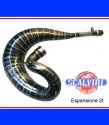JT, The second silencer picture is a good example of spreading it out over a large area. If it was steel like your pipes probably are the best thing to do is form a doubler patch square or rectangular in the shape that fits the contour of the area you want the mount to be and then weld the mount to the patch piece, then weld that to the pipe.
If the mount breaks it has to pull the whole patch plate off with it. Also brazing is best for any thick to thin sections like the flange or mounts attached directly to any of the cones. This stops undercutting on the all important thinner cones material and again making weak spots. Or use a Tig welder using silicon bronze filler rod as that's not really welding (it's brazing) to the parent metal and will help it from cracking at that point. Thick mount against the thin sheet metal, not good.
One look at this example of a Scalvini pipe shows exactly what I'm talking about, the stinger, the end of the stinger, all the mounts, the cylinder head flange, the spring loops, etc. are all brazed and this companies pipes compare to no elses ones craftsmanship. They have the best workmanship in the world in my opinion and they are only about $100.00 more for this piece of art compared to a hammered out piece of "shite" like most stamped cone pipes from any other company. Period.
The ones that are stamped out, stretched and then welded and plated are even worse for cracks to happen to them as the plating process itself makes them even more brittle as embrittlement is a result of the plating and from the plating itself. Look it up! Chrome, Nickel. etc. Not good for any stressed components on race car parts that are fabricated from 4130 chromoly. Or any alloy steels for that matter.
I'll bet you Scalvini won't even plate one of there pipes even if you paid them extra.
Even painting one of these Scalvini pipes is sacrilege in my opinion.
All the pipes I've made over the last 35 years only got coated with cooking or salad oil at first and then again they got glazed with a good wiping of salad or cooking oil during its first warm up. That's it.
Any kind of Paint gets sticky when curing and then everything in sight sticks to it and causes a set up for future hidden corrosion. Plus it can't be easily inspected for failure or cracks either.














